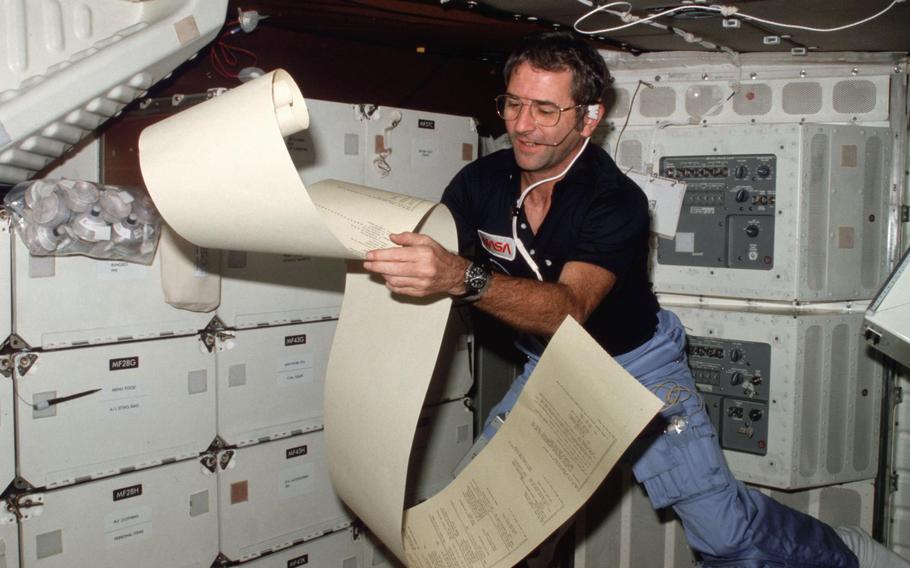
Adm. Richard H. Truly aboard the space shuttle Columbia in 1981. (NASA)
Richard H. Truly, a naval aviator, test pilot and astronaut who helped rebuild NASA’s space shuttle program after the Challenger explosion in 1986 and later oversaw the entire space agency as its top administrator, died Feb. 27 at his home in Genesee, Colo. He was 86.
NASA announced his death. The cause was complications from atypical Parkinson’s disease.
A retired vice admiral who logged more than 7,500 flight hours in his dual Navy and NASA careers, Truly was the first astronaut to lead the space agency when President George H.W. Bush appointed him to the post of administrator in 1989.
Truly had made his first spaceflight on Nov. 12, 1981 — his 44th birthday, an occasion spectators marked by singing “Happy Birthday” as he and his fellow astronauts approached the launchpad — when he piloted the space shuttle Columbia on its second mission. It was the first time, according to NASA, that a piloted craft was reflown in space.
Two years later, in 1983, Truly served as commander of the third mission of the Challenger when it became the first shuttle to launch and land at night.
He returned to naval service and was at the helm of the Naval Space Command in Dahlgren, Va., which oversaw the Navy’s surveillance and communications satellites, when NASA experienced one of the worst tragedies in its history.
On Jan. 28, 1986, the Challenger, poised to make its 10th trip to space, exploded 73 seconds after liftoff, killing all seven crew members, including Christa McAuliffe, a New Hampshire teacher who had been selected as the first civilian to be sent into space.
Within weeks, Truly returned to NASA to serve as associate administrator for space flight, tasked with reviving the space shuttle program along with the spirits of the people who worked on it.
He was widely considered a success on this front, overseeing a $2 billion repair and redesign project. On Sept. 29, 1988, the space shuttle Discovery took American astronauts to space for the first time since the Challenger disaster.
Truly oversaw a total of 20 space shuttle missions as associate administrator and then administrator at NASA.
After his promotion to the top job, Truly was widely reported to have clashed in his vision for the agency with Vice President Dan Quayle, who chaired the National Space Council, an advisory panel to the White House.
While Truly vigorously promoted the space shuttle program as well as the development of the International Space Station — both massive and expensive undertakings — the council complained that NASA moved too slowly and with too little regard for cost.
Rather than relying on internal expertise, members of the council said, the agency should draw from the private sector and academia for greater innovation in the development of its technology.
In addition, NASA suffered embarrassments over launch delays, technical problems with shuttles and damaged equipment on the Hubble Space Telescope and the Galileo spacecraft sent to Jupiter.
In 1992, Truly resigned, but his departure was widely characterized as a firing, and he said that he was “floored” and that it was “not my idea.”
He “did an extremely valuable job in getting the shuttles flying again, and restoring a sense of integrity to the agency,” John Logsdon, an adviser to the council, told The Washington Post at the time. But he also said that Truly’s “vision of the future was not compatible with the realities of the world.”
After leaving NASA, Truly led the Georgia Tech Research Institute, a nonprofit research arm of his alma mater, the Georgia Institute of Technology, and the Energy Department’s National Renewable Energy Laboratory.
Richard Harrison Truly was born in Fayette, Miss., on Nov. 12, 1937. His father was a lawyer for the Federal Trade Commission, and his mother was a teacher.
Truly had no particular ambition to become an aviator when he was young, taking pleasure in the more sedate activities of stamp collecting. In becoming an astronaut, he told the New York Times in 1981, he “just kind of stumbled from one good opportunity to the other.”
He received a bachelor’s degree in aeronautical engineering from Georgia Tech, which he attended on a Navy ROTC scholarship. He joined the Navy after his graduation in 1959.
Serving in a fighter squadron aboard aircraft carriers, he developed a specialty in night landings, experience that he would call upon years later in the space shuttle program.
“Fear is a nice, healthy phenomenon,” the Times once quoted Truly as saying. “Any pilot who says he’s never been scared is lying.”
He later was a test pilot and test pilot instructor before becoming a military astronaut attached to the Air Force’s Manned Orbiting Laboratory program in Los Angeles.
He joined NASA in 1969. Before making his first space flights, he worked on communications for Skylab, the first U.S. space station.
His honors included two NASA Distinguished Service Medals, as well as the Defense Distinguished Service Medal, the Defense Superior Service Medal, two Legions of Merit, the Navy Distinguished Flying Cross and the Meritorious Service Medal.
Truly was married to the former Colleen “Cody” Hanner. Besides his wife, of Genesee, survivors include their three children, Mike Truly of Crested Butte, Colo., Dan Truly of Los Angeles and Lee Truly Rumbles of Denver; five grandchildren; and six great-grandchildren.
Truly’s flight aboard the Columbia in 1981, in addition to occurring on his birthday, made him the first American grandfather known to have entered space.